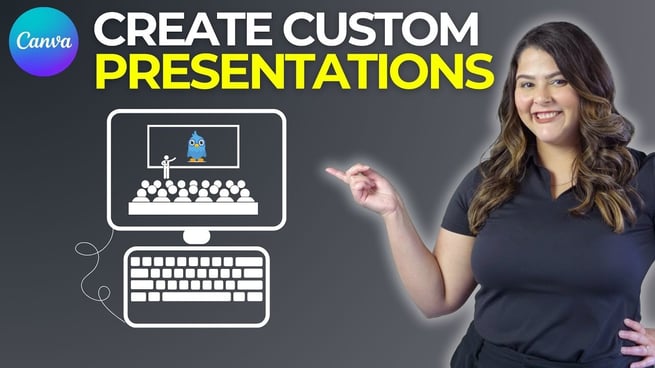Creating Custom Presentations in a SNAP | Canva Tutorial

Helen Devlin introduces beginners to the exciting world of custom presentation creation in Canva. For those who have felt overwhelmed by the platform, Devlin’s tips and tricks provide an easy way to get started. This blog post condenses her video tutorial into a simple guide, offering helpful insights for anyone looking to create professional presentations with ease.
Getting Started with Canva
When you first open Canva, the variety of options can feel daunting. However, Devlin encourages users to begin by choosing the presentation format from the homepage. This straightforward approach sets the foundation for creating a visually appealing and well-structured presentation. From here, you can:
- Choose a blank canvas and search for templates within Canva’s design studio.
- Search for specific templates directly from the homepage.
By searching for templates based on your needs (like a sales pitch or marketing strategy), Canva provides a wide selection of designs tailored to different purposes.
Choosing the Right Template
Devlin advises selecting templates that align with the overall tone and aesthetic of the presentation. While there are plenty of premade templates available, she highlights that customizing these templates can save time, especially when they feature animations or other interactive elements.
When searching for templates, it's essential to:
- Filter results by presentation format to avoid unrelated types like Instagram posts.
- Be aware of the "crown" symbol on pro elements, indicating premium features available only to Canva Pro users.
Devlin demonstrates how to narrow down your options by filtering templates that fit a specific theme, such as a coffee shop sales pitch, ensuring the visuals match the brand identity.
Customizing Your Template
Once a suitable template is selected, the customization process begins. Devlin explains how to modify the design elements to fit your brand. Some of the steps she covers include:
- Changing background colors: By clicking the color bar at the top of the design, users can choose from pre-set document colors or enter custom hex codes for brand consistency.
- Using the Brand Kit: Canva's Brand Kit feature allows users to store their brand colors, fonts, and logos, making it easy to maintain a cohesive brand identity across multiple designs.
- Replacing images: Devlin shows how to replace stock images with personalized logos and photos, including using Canva's "background remover" tool (available for Pro users) to remove unwanted backgrounds from images.
By using these customization tools, users can ensure that the final presentation closely aligns with their specific branding guidelines.
Duplicate and Reuse Slides
In many presentations, certain slides need to be repeated or adjusted for consistency. Devlin provides an easy solution by showing how to duplicate slides with customized elements. This ensures that layouts remain consistent throughout the presentation without having to redesign each slide.
Advanced Design Features
For those looking to further enhance their presentations, Devlin introduces Canva's Magic Recommendations feature. This tool provides design suggestions based on the elements already included in the presentation. Whether you’re looking for similar graphics or color schemes, Magic Recommendations helps you find cohesive additions that fit the overall look of your project.
Final Touches
After adjusting the colors, images, and layouts, Devlin emphasizes the importance of making the text personal to your company or project. In her example, she customized a coffee shop presentation for her fictional brand, "Bold Brews." She then demonstrates how to hide or delete resource pages and finalize the design before presenting.
- Hide or delete pages: If you’re working with template slides that are only for internal use (like resources), you can hide them before presenting.
- Exporting your presentation: Canva allows users to download presentations in various formats, including PowerPoint, PDF, and more.
Conclusion
With the right approach, creating a custom presentation in Canva can be a smooth and enjoyable process. Helen Devlin’s tutorial provides practical advice for beginners who want to create professional presentations without starting from scratch. For those who wish to dive deeper into Canva’s capabilities, Devlin offers additional resources, including an upcoming Canva course for beginners on Pragmatic Works' on-demand learning platform.
Key Takeaways
- Canva's templates are an excellent starting point for custom presentations.
- Customize templates by changing colors, images, and text to reflect your brand.
- Use the Brand Kit for consistent brand management across all your designs.
- Utilize Magic Recommendations for design suggestions and tweaks.
- Present directly from Canva or export to PowerPoint for offline use.
Don't forget to check out the Pragmatic Works' on-demand learning platform for more insightful content and training sessions on Canva and other Microsoft applications. Be sure to subscribe to the Pragmatic Works YouTube channel to stay up-to-date on the latest tips and tricks.
Sign-up now and get instant access

ABOUT THE AUTHOR
As a trainer at Pragmatic Works, Helen Devlin's primary goal is to help individuals gain confidence in using the Power Platform. Helen is a Jacksonville native who graduated from the University of North Florida with a Bachelor's degree in Elementary Education in 2016. After 9 years of teaching varying grades (K-5) in Florida and Tennessee, she joined the Pragmatic Works team as a Power Platform Trainer. While not in the office, she enjoys coffee, brunch, local parks, and spending time with her family.
Free Community Plan
On-demand learning
Most Recent
private training



-1.png)
Leave a comment